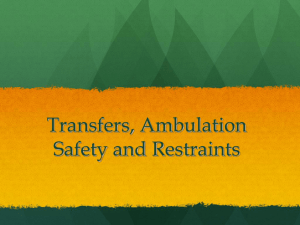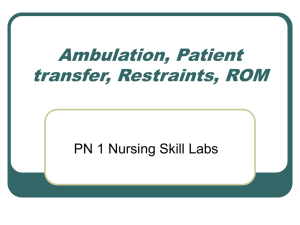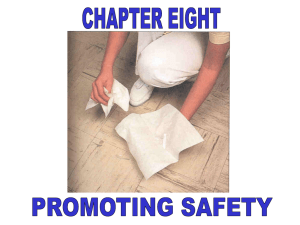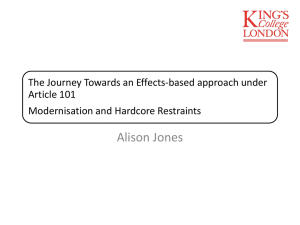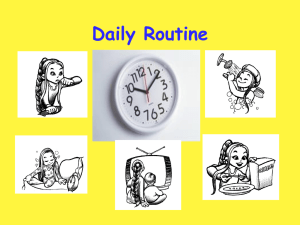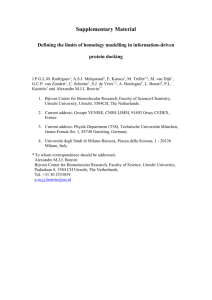Transfers, Ambulation and Restraints
advertisement
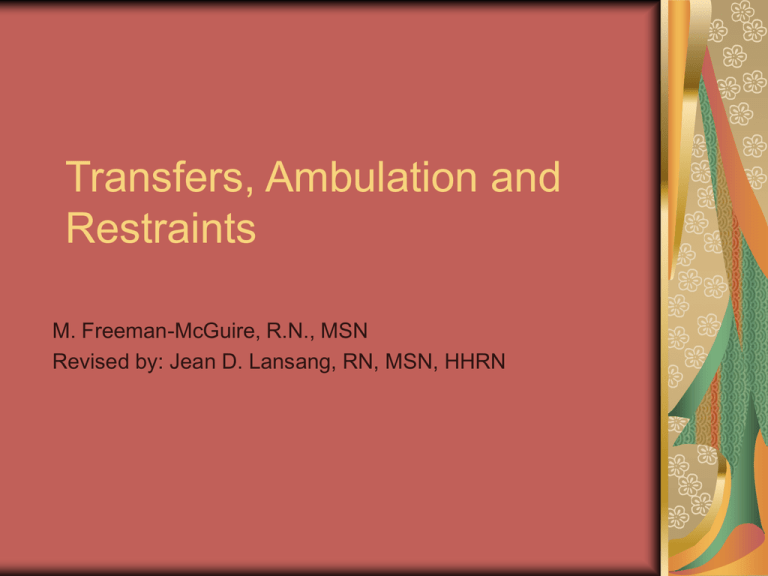
Transfers, Ambulation and Restraints M. Freeman-McGuire, R.N., MSN Revised by: Jean D. Lansang, RN, MSN, HHRN Lesson Objectives (Transfers), By the end of this lesson the student vocational nurse will be able to: Describe the procedure for transferring the client: moving up in bed, bed to chair, bed to stretcher, chair to bed, Explain at least three safety factors practiced while performing a transfer List common hazards encountered during a transfer Explain the importance of knowing the diagnoses and capabilities of the client Lesson Objectives (Ambulation), By the end of this lesson the student vocational nurse will be able to: List common hazards of ambulation and of using assistive devices Explain the importance of knowing the diagnoses and capabilities of the client Describe methods to support the client during ambulation Discuss various gaits used for walking with a cane, walker or crutches Create sample charting after ambulating a client, including the important data Lesson Objectives (Restraints), By the end of this lesson the student vocational nurse will be able to: Discuss rationale for using restraints Define the terms immobilize, legal rights, limb holder, chemical restraints Explain the patient’s Bill of Rights regarding consent of the client, family or guardian and written medical orders for use of restraints Discuss the procedure for applying various physical restraints Transfers, Ambulation, Restraints Safety !!!! Transfers, Ambulation, Restraints (Safety Interventions): Assess for Orthostatic Hypotension Dangle Client with special needs: (eg.) blind Lock wheel chairs, stretchers and beds Check floors for safety (wet or clutter) Tub and shower surfaces Non-skid slippers Common Hazards Encountered: Unable to assist or follow directions Client fear Client fatigue Client weak Problem with assistive devices Inexperience of nurse Size of client Size of nurse Supporting The Client: Physically Emotionally Psychologically Tips: Moving from bed to chair: Chair on strong side Pivoting (client’s hand on arm of chair) Ambulating A Client: Support weak side Match client’s gate Basic Nursing Care: Comfort Safety Change Position Chair Cushions ROM Exercises Orientation of Client Therapeutic Touch Personal Items near Client Client Daily Habits ADL’S Documentation: Time Distance Use of Assistive Devices Client’s Feelings Weakness Poor Balance Dizziness Posture Other Problems Number of People to Assist Procedure for Transfers: Check the doctor’s orders Dangle (usually necessary-after BR) Assist client to a sitting position, legs at side of bed, not touching the floor Allow client to dangle for several minutes May be necessary to return client to bed Orthostatic Hypotension (Signs and Symptoms): Dizziness Weakness Faint Fatigue Lightheadedness Orthostatic Blood Pressures: Lying Sitting Standing Orthostatic Hypotension: Systolic Blood Pressure drop < 25 mm Hg Diastolic Blood Pressure drop < 10 mm Hg Equipment (Transfers): Wheel Chair with Replacement Arm Geri Chair Transfer Belt Sliding Board Mechanical Lifts (Hoyer) Bed Scale Pull Sheet Moving Client Up In Bed: Position on back Ask client to bend knees and push with feet on the count of three Nurse assist client to the top of the bed (usually two person assist) Use good body mechanics Transfer (Two Person): Very overweight client Confused client Uncooperative client Transfer To Chair from Bed: Dangle Position (may be first step) Stand Pivoting (client’s arm on the arm of chair) Place chair on the client’s strong side Ambulation (common hazards with assistive devises): Broken Client not know how to use Pathways are not clear Equipment (ambulation) Same with few exceptions Gait Belts Crutch Walker Ambulation: Prevent Falls !!! Client Posture (head up, eyes open, looking forward) Non-skid slippers Walk at client’s side Match client’s gate Ambulation (Procedure): Walk on client’s weak side/match gate Stabilization (allow client to hold your elbow or hand) Minimal Support (hold client’s arm with your hand) Moderate Support (encircle client’s waist with your hand) Maximum Support (two persons, one on each side of client) Preventing Falls: Floors Clean and Dry Floor Free from Clutter Anticipate Client Needs (toileting etc.) Know Client’ Diagnosis (eg.) CVA Blind Client’s, Alzheimer's Keep Belongings and Call Light in Reach, Bed in Low Position and Locked, Side Rails (!!!) Breaking Client’s Fall: Stand with your feet apart slightly behind the client Grasp the client firmly at waist/axilla Your near leg against the client’s leg Slowly lower the client to the floor Examine for injury Call for help Document as per agency policy Doctor notified Restraints: Purpose Applied for safety Prevent injury Prevent dislodgement of tubes Psychiatric Setting Restraints Legal Consideration: Must be ordered by a physician in writing Emergency (can be applied by a nurse, orders within 24-48 hours) Documentation (all that was done to remedy situation before applying) Restraints: Must !!! Must help client or be needed for medical therapy Must be ordered by a physician Must not be used as a means of pushing or disciplining the client Must be applied snugly/not tightly Must be removed/Reposition Q2 Must notify doctor when no longer needed Must intervene to promote safety Must be documented Restraints Types: Safety Belts Wrist Extremity Immobilizer Vest (Posey) Hand Mittens Leather Chemical Restraints Basic Principals: Know agency policy Check client Q 15 minutes Remove and reposition Q 2 hours Assist with ROM Call light in reach Comfort measure (eg) water, food, rest room Family Diversional Activities Psycho/Social (tough, isolation, confusion) Client’s daily habits (eg) news paper Neuro/Vascular Assessment Rapid Release of Restraints Restraints Long Term Use (problems): Muscle weakness, atrophy Loss of bone mass, joint contractures Constipation/incontinence Pressure Ulcers Cognitive Impairment Decrease confidence in ambulation Withdrawn, detached Depression Loss of independence Conclusion Ask Yourself: Is my client safe from harm? Does my client need anything? Is the bed locked? Is the bed in the low position? Is the call light in reach? Does my client have anything to do? How is my client’s neuro/vascular assessment? Physical Restraints Restrict or control movement or behavior. They may be attached to a person's body or create physical barriers. wrist vest side rails wheelchair safety hand mittens Chemical Restraints - are any medication used for the purpose of restraining patients involuntarily to prevent them from harming themselves or staff. Advantages of chemical restraints Control violent behavior and patient agitation May reduce need for physical restraints Allow examination and performance of radiographic imaging Disadvantages of chemical restraints •May result in complications, such as respiratory depression and loss of gag reflex •Occasional paradoxical reaction results in increased agitation •Limit mental status assessment and neurologic examination during sedation Environmental restraints change or modify a person's surroundings to restrict or control movement. For example, a locked door. Title XXII and Legal Rights of the Elderly Policies and procedures which contain competency standards for staff performance in the delivery of patient care shall be established, implemented, and updated as needed for each nursing unit, including standards for the application of restraints. Standards shall include the elements of competency validation for patient care personnel other that registered nurses as set forth in Section 70016 Rights of the Elderly
